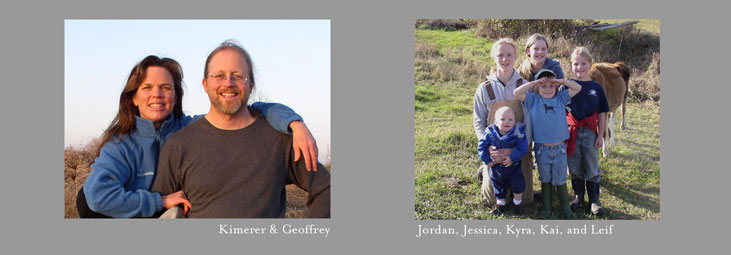 |
|||||||||||||

Early in 2005 I was an academic—a professor at Brown and then Harvard; recipient of fellowships from the Radcliffe Institute (2000-1) and the Center for the Study of World Religions (2003-4); and author of two books and many articles in religion and dance. I was happily married, and the mother of three beautiful children. I was practicing, choreographing, and performing as a dancer. I was not happy. Something inside of me was bunched up, longing to unfold. It seemed as if the parts of my life were pitted against each other—work versus family, teaching versus scholarship, dancing versus writing. I felt drained by the effort of holding them all together. I could not imagine cutting out one for the sake of the others. My creativity flows in all directions or none at all. |
It was hard to believe we were even considering the move to the farm when we did. It was several years before we thought we would do it, and it meant leaving my faculty positions, my local gigs, and even the beautiful Steinway that was on loan to me at the house. Still, I knew from before: As long as the move I am making is a move toward my art, the risk will always be rewarded in more ways than I can imagine. After leaving my full time post at Kurzweil in '98 to focus on performance, not only did I advance my career as a pianist, but I discovered a talent for music education, and began tapping a rich vein of ideas in theory and analysis. I also learned the joys of raising the children and began building my business as a sound design contractor. This time Kimerer's art was the primary force for moving (her book had to be written from this place), and I had planned to find teaching work to help support us while we rehabilitated the farmstead. |
|||||||||
I wanted to live a life where the strands of my creativity did not pull so violently against one another. I wanted to live a life where I could affirm the inextricable weave of writing, dancing, and loving as who I am. I wanted to pursue a dream Geoff and I had had for years of moving to the country and creating this life. |
 |
When no teaching work surfaced, I almost decided to chuck music altogether and become a full-time farmer. Well not really, but it sure was tempting! It was in doing work for two companies, SoniVox and Synthogy, that I had the idea for the first artistic |
||||||||
In May of 2005, when the opportunity arose to buy this farm, I leapt. A month after the move I gave birth at home to our fourth child. After a second month of making habitable spaces for all, I began to write. I began to dance. When I did, what came out in my work was an expression of my life up until now—a thick braid, woven from my experiences studying religion, practicing and performing dance, and living life with Geoff and our children. It suddenly became clear: the move to the farm was providing me with the experiences I needed to advance the critique of western culture I had begun to develop during my years in the academic world. Here on the farm, I would grow an alternative—a philosophy of bodily becoming—a way of thinking, feeling, and acting that honors bodily movement as the source and telos of human life. I began to write a series of three books about why movement matters in our relationships with our selves, our loved ones, and the natural world. A first book emerged—What a Body Knows: Finding Wisdom in Desire (2009)—and then a fifth child, born again at home. A second book followed—Family Planting (2011) . A third emerged to complete the trilogy—Why We Dance (2015)--with each one uniquely fed by the dancing and singing, the farming and the thinking that living here enables. Cick here for more about Kimerer, her writing and her dancing. |
"fruit" of my time here on the farm. Both companies produce excellent virtual instruments which use hard disk streaming to enable a regular PC to produce authentic acoustic instrument sounds you can play on an attached musical keyboard. Synthogy makes Ivory, which is focused on piano and is widely considered to be the state of the art piano sound today. SoniVox makes Muse, which contains hundreds of different instruments---an entire orchestra of sounds. It occurred to me that I could use this technology not just to recreate existing acoustic instruments, but to invent entirely new ones. I could use it to make instruments out of sounds I have always loved, but never could play. The farm provided what I needed, from the old baby grand piano to strum on, to the dead twigs to break in the pine forest by the pond. So I spent the year preparing instruments and recording them, collecting natural sounds and sorting them, and voicing them all into the collection called Plectrum. I am happy to share the instruments as well as the music that can be made with them--early fruits of Hebron Hollow Farm. |
|||||||||
